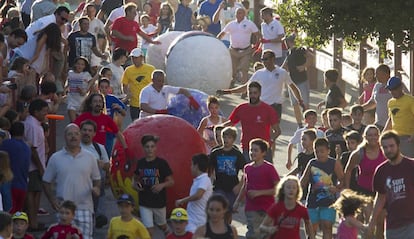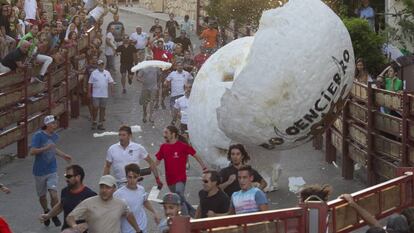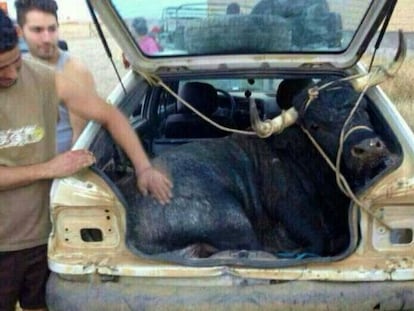Could you survive Spain’s Indiana Jones-style boulder run?
Madrid village is exporting its own peculiar take on the tradition of the Running of the Bulls
Think Indiana Jones meets a Sanfermines bull run: you’re in a small village in the mountains close to Madrid, rushing downhill through a series of narrow lanes packed with other adventure seekers, all pursued by a 200-kilogram polystyrene ball measuring three meters across.
Welcome to Matalpino, some 50 kilometers northwest of Madrid in the Guadarrama mountains, which has just celebrated the sixth year of its “Boloencierro” (a word made up from bolo, for ball, and encierro, bull run).
In August 2011, as Spain struggled to deal with a worsening economic crisis, the local council discovered it lacked the funds to hold its annual fiestas, which traditionally included bullfighting and bull runs.
Anybody thinking that the ‘boloencierro’ might replace bull runs would be wrong, says Matalpino’s mayor
But Mayor Javier de los Nietos of the Socialist Party (PSOE) had a bright idea: instead of bulls, the community of 1,700 people would invest in polystyrene boulders and take advantage of the town’s up-and-down topography.
Since then, what started out as a homespun solution has put Matalpino on the global tourist map, attracting television stations from as far afield as Japan and China.
Earlier this year, the local council registered Boloencierro Matalpino as a trademark and now plans to export its brand around the world.

The Boloencierro Matalpino export version is for children, explains De los Nietos. It uses smaller, lighter boulders that are also irregular in shape, meaning that they bounce around more. The danger here isn’t so much being squashed by a polystyrene rock, but tripping and ending up with scratches and scuffs. “We recommend children wear long trousers and a long-sleeved shirt,” explains De los Nietos.
This summer some of the fiestas held in the mountain villages north of Madrid will feature the Boloencierro Matalpino: Torrelaguna (September 3), Cercedilla (September 10), Navacerrada (September 11), and Moralzarzal (October 1).
De los Nietos says he has been in talks with Pamplona, home of the Sanfermines fiestas in July, to include the Boloencierro at Sanfermín Txikito, a smaller fiesta with no bull runs that is held at the end of September in the old town of the city.
In Matalpino itself, the Boloencierro takes place over the course of the weekend of the first week of the fiestas, in mid-August. The children’s version is staged first, using colored mini-boulders, followed by the adult event, which in years past has been repeated up to three times. This year, however, the second run ended halfway through when the boulder split in two halfway through the event.
Matalpino is now on the global tourist map, attracting television stations from as far afield as Japan and China
But anybody thinking that the boloencierro might replace bull runs would be wrong, says De los Nietos: “It’s not something that divides bullfighting aficionados from opponents: in fact it brings them both together; everybody enjoys the party.” In short, Matalpino continues to stage bull runs, holding one each evening and another two during the day over the course of the first weekend of its fiestas.
De los Nietos, who says that in his younger days he ran with the bulls, explains the Boloencierro: “You feel very small, and you have to keep your wits about you, because if the boulder cracks you on the back, it can push you against the walls or onto the ground.” There have been cases of people being concussed.
“There tend to be more injuries in the Boloencierro than during the bull runs, I guess because people don’t take the right precautions,” says the mayor. This year four people were injured trying to outrun the polystyrene boulder. Two of them ended up in hospital.
English version by Nick Lyne.
Tu suscripción se está usando en otro dispositivo
¿Quieres añadir otro usuario a tu suscripción?
Si continúas leyendo en este dispositivo, no se podrá leer en el otro.
FlechaTu suscripción se está usando en otro dispositivo y solo puedes acceder a EL PAÍS desde un dispositivo a la vez.
Si quieres compartir tu cuenta, cambia tu suscripción a la modalidad Premium, así podrás añadir otro usuario. Cada uno accederá con su propia cuenta de email, lo que os permitirá personalizar vuestra experiencia en EL PAÍS.
¿Tienes una suscripción de empresa? Accede aquí para contratar más cuentas.
En el caso de no saber quién está usando tu cuenta, te recomendamos cambiar tu contraseña aquí.
Si decides continuar compartiendo tu cuenta, este mensaje se mostrará en tu dispositivo y en el de la otra persona que está usando tu cuenta de forma indefinida, afectando a tu experiencia de lectura. Puedes consultar aquí los términos y condiciones de la suscripción digital.
More information
Últimas noticias
A hybrid building: Soccer pitch, housing, and a shopping mall
Europe urges Trump to respect Greenland following annexation threats
Science seeks keys to human longevity in the genetic mixing of Brazilian supercentenarians
Luisa Neubauer, climate change activist: ‘Ecology shouldn’t be a punitive force, but a joyful and liberating one’
Most viewed
- Alain Aspect, Nobel laureate in physics: ‘Einstein was so smart that he would have had to recognize quantum entanglement’
- Mexico’s missing people crisis casts a shadow over World Cup venue
- Alvin Hellerstein, a 92-year-old judge appointed by Bill Clinton, to preside over Maduro’s trial in New York
- Why oil has been at the center of Venezuela-US conflicts for decades
- Cuba confirms death of 32 of its citizens in the US attack against Venezuela












































